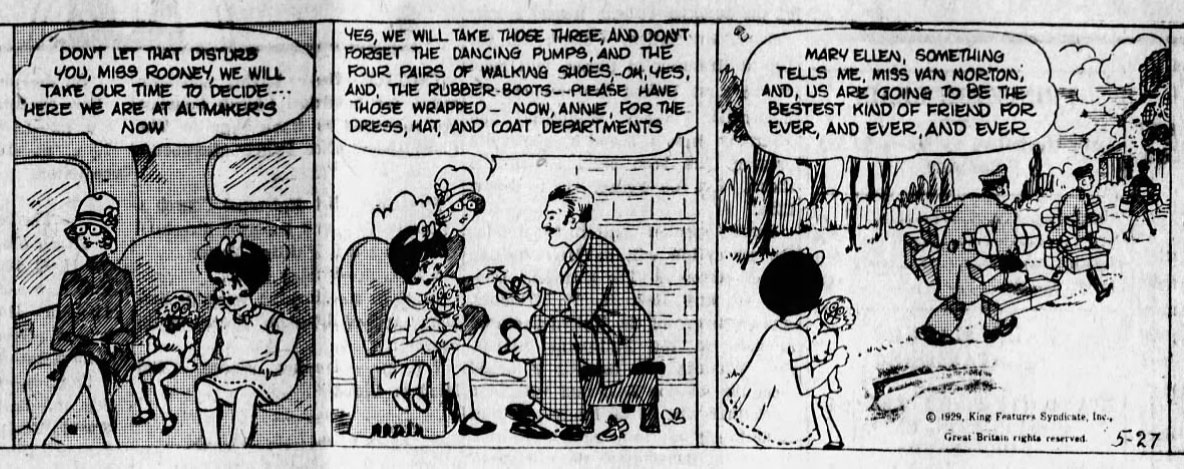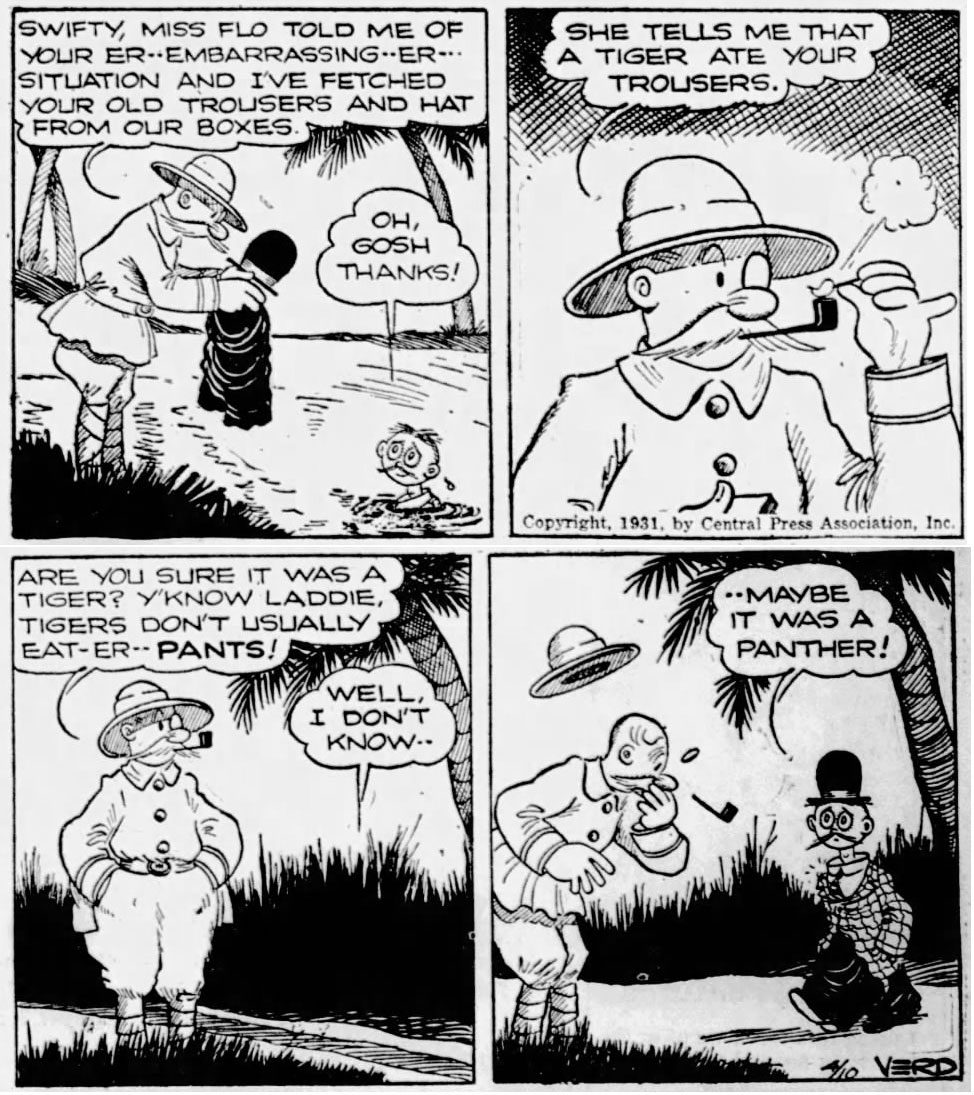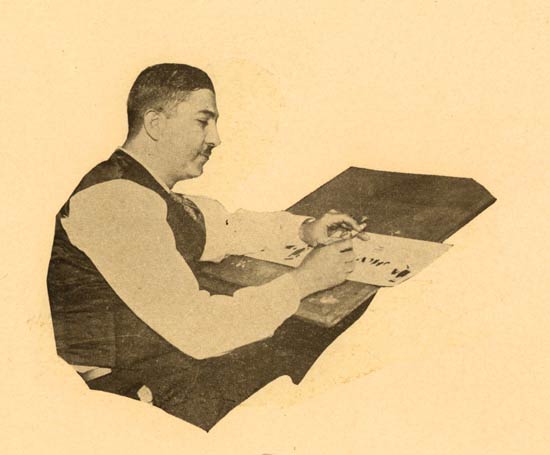'Little Annie Rooney', 25 July 1928.
Ed Verdier, who signed with "Verd", was a mid-20th century American cartoonist, and the first artist to draw the iconic melodramatic series 'Little Annie Rooney' (1927-1966) (not to be confused with Harold Gray's 'Little Orphan Annie'). While he only drew 'Little Annie Rooney' during the first two years, the feature inspired a lot of merchandising, while new episodes kept running in papers until 1966. Verdier also drew shorter-lived comics, like 'Swifty' (1930-1931) and the gag cartoon 'Chirps and Chuckles' (1937), and he was one of several artists to continue 'Embarrassing Moments' (1925-1927).
Early life and career
Edward Edmond (sometimes spelled as "Edmund") Wellington Verdier was born in 1897 in San Francisco, California into a family of French descent. His father Edward worked as an embroidery designer. In an article in the Casper Star Tribune (13 October 1930), it was described how Ed Verdier had experienced the 1906 San Francisco earthquake: "Edward E. Verdier was getting ready to go to school on the morning of April 18, 1906, in his home, in San Francisco, when the house began to tremble. At the time he was standing before a mirror, tying his tie. Suddenly the heavy glass and frame was shaken loose and dropped on his head, inflicting the only casualty he suffered during the three thrilling days of the San Francisco fire." Later that year, his mother Louise passed away, and his father later remarried.
In 1910, when he was thirteen years old, Ed Verdier was listed in the drawings department of the youth magazine St. Nicholas. It took a while before his professional career in cartooning took off, though. By 1917, he lived in El Camino Real, Burlingame, California, working as a window trimmer. During the First World War, he served with the U.S. Navy, and returned to civilian life in 1921. Residing in Oakland, California, Verdier worked as a showcard writer and architect. At some point during the 1920s, he moved to New York City, where he had his cartooning career with King Features Syndicate.
Embarrassing Moments
At King Features, Verdier's earliest cartooning contributions happened between 30 November 1925 and January 1927, when he was assigned to draw the gag panel 'Embarrassing Moments'. As the title implies, the series featured several humorous incidents that bring characters into shameful or awkward situations. 'Embarrassing Moments' was originally launched in 1922 by Jack Farr, with various artists ghosting the series until 1932: Billy DeBeck, Charles Dunn, W.G. Farr, Paul Fung, George Herriman, Jay Irving and Darrell McClure.
'Little Annie Rooney' (8 July 1929).
Little Annie Rooney
In 1927, Verdier created his best-known comic, 'Little Annie Rooney', although it probably wouldn't have existed if it weren't for newspaper magnate William Randolph Hearst, owner of King Features Syndicate. At the time, Hearst already had countless popular comic series in his papers, but, much to his frustration, he didn't have Harold Gray's 'Little Orphan Annie' (1924), which was syndicated by the (Chicago) Tribune Media Services. Since he couldn't buy out Gray, he decided to have the concept copied, and Ed Verdier was commissioned to create a thematically similar series.
On 10 January 1927, the first episode of 'Little Annie Rooney' saw print in the Hearst papers. Just like Gray's comic, Rooney is an orphan girl named Annie, who wears a red dress and has a puppy dog, Zero. Her name was inspired by the film 'Little Annie Rooney' (1925), starring Mary Pickford, in itself based on Michael Nolan's 1890 song 'Little Annie Rooney'. Incidentally, in August 1902, U.S. cartoonist Charles A. Voight had already drawn a short-lived newspaper comic titled 'Little Annie Rooney', which ran in The New York Evening World for about a month.
Verdier's 'Little Annie Rooney' is a melodramatic serial, focusing on Rooney's harsh and pitiful existence. At the start of the series, she lives in a nightmarish orphanage, where she is tormented by cruel teachers, including the principal, Miss Hannigan, and Rooney's personal legal guardian, Miss Meany. The little girl often escapes, but Miss Meany tirelessly tries to track her down and bring her back to her hellish orphanage. This gives the stories a recurring threat to keep readers in suspense.
Ed Verdier's 'Little Annie Rooney' enjoyed a long, successful run. It ran for nearly 40 years and spawned a lot of merchandising. The 1935 film 'Ginger', directed by Lewis Seiler, started out as a movie adaptation of the comic, but for unknown reasons all references to the series were eventually removed. Throughout the mid-1930s and 1940s, newspaper episodes of 'Little Annie Rooney' were also reprinted by Big Little Books, David McKay and St. John.
Nevertheless, due to failing eyesight, Verdier only drew 'Little Annie Rooney' for about two years. In July 1929, King Features replaced him with Ben Batsford, who was succeeded in October of the following year by Darrell McClure and a new writer, Brandon Walsh. In 1934, 'Little Annie Rooney' received a Sunday page, drawn by Nicholas Afonsky. After Afonsky's death in 1943, McClure continued the Sunday edition too with some assistants by his side: Bob Dunn and Fran Matera. The trio continued the series until 16 April 1966.
'Little Annie Rooney' (Princeton Daily Clarion, 1 June 1929).
Similarities and differences with 'Little Orphan Annie'.
Right from the start, almost every reader familiar with 'Little Orphan Annie' was aware that 'Little Annie Rooney' was an obvious concoction of the former. The title, set-up and drama were similar. Rooney and her dog Zero were carbon copies of Annie and her mutt Sandy. Both orphan girls have catchphrases: Rooney frequently says "Gloriosky!", while Annie exclaims "Leapin' Lizards!". Still, there are a few notable differences. Annie has curly red hair and Rooney a black bob cut. Sandy is a red-haired terrier, while Rooney's dog Zero is a white-haired terrier. In her ordeals, Rooney also had it much tougher than Annie. While Annie at least has Daddy Warbucks to come to her rescue and serve as a father figure, Rooney has nobody but her dog and her doll, Mary Ellen.
Nevertheless, most audiences had trouble telling 'Little Orphan Annie' and 'Little Annie Rooney' apart. This undoubtedly explains why the series never reached the same success as the original. Given the fact that the title 'Little Annie Rooney' was based on a pre-existing song and a Hollywood movie, while its artwork and themes aped Gray's comic, it's remarkable that the series was never sued for plagiarism.
Parodies of and references to 'Little Annie Rooney'
As early as the 1930s, 'Little Annie Rooney' was one of several newspaper comics turned into pornographic parody, as part of the 'Tijuana Bibles' phenomenon. Inspired by the title confusion between 'Little Orphan Annie' and 'Little Annie Rooney', Harvey Kurtzman parodied both at the same time in the spoof comic 'Little Orphan Melvin', drawn by Wallace Wood and published in Mad Magazine issue #9 (March 1954). Kurtzman and Will Elder's later comic, the frivolous 'Little Annie Fanny' (1962-1988), also started out as a mixture between 'Little Orphan Annie' and 'Little Annie Rooney', with the big-bossomed title character sometimes saying "Gloriosky!", and other times "Leapin' Lizards!". As Kurtzman had a strong dislike of both comics, he enjoyed targeting them regularly.
However, 'Little Annie Rooney' did enjoy the honor of being alluded to by James Joyce in his experimental novel 'Finnegans Wake' (1939), and the comic was ridiculed in Spike Jones' song 'The Funnies' (1946). Likewise both Orphan Annie's catchphrase "Leapin' Lizards" and Annie Rooney's signature line "Gloriosky" were referenced in the song 'Gee, Officer Krupke!' from the 1957 theatrical musical 'West Side Story' by Leonard Bernstein and Stephen Sondheim.
Swifty, Chirps and Chuckles and other comics
After leaving 'Little Annie Rooney', Verdier continued his cartooning career with intervals. Between 13 October 1930 and 18 July 1931, he worked for the Central Press Association, creating the comic strip 'Swifty', about a Chaplin-esque man in an ill-fitting dress and innocent look, who is always down on his luck. In an introductory interview with the Casper Star-Tribune (13 October 1930), Verdier said that 'Swifty' was the type of comic he had been wanting to draw ever since he was in the newspaper business. But even though it had been ten years in the making and presumably his most personal comic creation, the feature lasted only a few months. From January until July 1937, Verdier was also one of the cartoonists contributing to the King Features collected gag panel page 'Chirps and Chuckles'. On 28, 29 and 30 October 1930, he also drew a drawing instruction page for the Berkeley Daily Gazette, which he signed "Verd".
Later life and death
Poor eyesight forced Verdier to give up his cartooning and painting activities in the 1930s, but he started a new career as a writer. He penned scripts for the radio serial based on Chester Gould's 'Dick Tracy' and later co-wrote several movies, including 'The Bride Wore Crutches' (1941), 'Song of the Open Road' (1944) and 'Delightfully Dangerous' (1945). He also wrote one novel, 'The Sun and the Barrow' (Ziff-Davis, 1948).
Ed Verdier moved to Los Angeles after 1935. During World War II, he enlisted again to serve his country. He died in 1976.
Ed Verdier.
Little Annie Rooney in the Toonopedia
Little Annie Rooney on junglefrolics.blogspot.com







